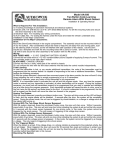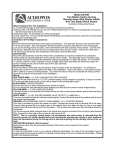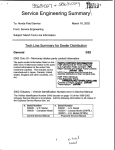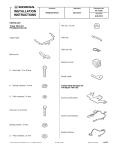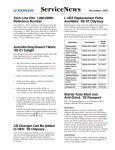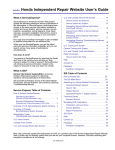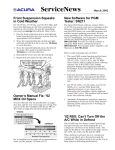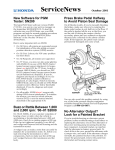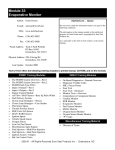Download ServiceNews
Transcript
ServiceNews April 2002 PGM Tester Software SN211: Some More Things to Know S/M Fix: ’02 VIN Decoder, ’99–02 Odyssey Here are some more things you should be aware of about PGM Tester software version SN211: Now that Odysseys are being produced in Alabama, the VIN decoder info on page 1-5 of the 1999–02 Odyssey Service Manual needs updating. Mark up your copies of the S/M to look like this: • On ’97–01 Civics, the VIN entry screen lists only the 1HG prefix; it doesn’t include the 2HG and JHM prefixes. You need to enter the VIN manually to use the PGM Tester on these vehicles. • If you’re running the EVAP System Function Test, and you get this message: “Fuel vapor flow too high or too much fuel in tank,” check the fuel level in the tank. If the fuel level is below F (Full), check if the purge control solenoid (PCS) is sticking or leaking. If the PCS is defective, replace it. Don’t Mix Up Fog Light and Cruise Control Connectors If you’re installing fog lights on a ’02 CR-V, don’t mix up the blue fog light switch connector and the gray cruise control connector. It’s really easy to do since both connectors have the same 5-pin arrangement and, except for their color, look identical. If you mix up the connectors, the fog light switch will work the cruise control and the cruise control switches can work the fog lights. However, you also get a few operating quirks: • The cruise control doesn’t work unless the fog light switch is also turned on. • The indicator in the cruise control master switch comes on only when the headlights are turned on. • The fog lights don’t work unless the cruise control master switch is turned on. • The indicator in the fog light switch comes on only when the switch is turned on and the ignition switch is in the ON (II) position. S/M Fix: Fuel Tank Capacity, ’01–02 Civic The fuel tank capacity on page 2-5 of the 2001–02 Civic Service Manual is incorrectly listed as 11.9 U.S. gallons. The correct capacity is 13.2 U.S. gallons. Make this change to your copies of the S/M. 000001 _: U.S. model Vehicle Identification Number and Federal Motor Vehicle Safety Standard Certification. Vehicle Identification Number and Canadian Motor Vehicle Safety Standard Certification. DTM Error Message With PGM Tester If the PGM Tester stops sending data through the data transfer module (DTM), and you see the message “TRANSFER ABORTED,” it means the Tech Line computer detected an abnormal data bit and hung up. The glitch can be either in the PGM Tester software, the captured data, or the phone line you’re using. If you’re having a hard time duplicating and capturing the data, you need to print your trigger point data and fax it to Tech Line at 310-783-3530 with your Tech Line reference number. But if duplicating and capturing the data was a snap, just reload PGM Tester software version SN211, recapture the data, and send it again. Reloading the software somehow seems to fix these data bit glitches. Water Leak Tip When repairing a water leak, here’s a handy tip: Check the accumulated water. If the accumulated water is dirty, look for leaks from the underside of the vehicle (floor, wheelwells, etc.). If the accumulated water is clean, look for leaks from the top side of the vehicle (trunk seal, windshield, roof strips, etc.). VTEC Engine Hesitates During Acceleration Use the International Phonetic Alphabet NOTE: This article applies to ’94–02 Accords with VTEC, ’92–02 Civics with VTEC, ’93–01 Preludes with VTEC, ’00–02 S2000s, ’00–02 Insights, and ’99–02 Odysseys. Our military folks have used it for years—the international phonetic alphabet. If you’re not familiar with it, it’s an ingenious way to avoid confusion when pronouncing similar sounding letters like “M” and “N” or “F” and “S.” If your customer complains that the engine hesitates briefly when accelerating, chances are the ECM/PCM is ordering fuel cutoff because of low or delayed engine oil pressure to the VTEC system. Typical causes for low or delayed oil pressure are low oil level, a dented oil pan that’s touching the oil pickup screen, or some other oil flow restriction. When the throttle opening, vehicle speed, engine coolant temperature, and engine speed indicate that VTEC is needed, the ECM/PCM turns on the VTEC solenoid valve. Oil pressure should immediately turn off the VTEC oil pressure switch. But if the switch stays on (because of low oil pressure), the ECM/PCM orders fuel cutoff and shuts off all the fuel injectors. Normally the ECM/PCM turns on the MIL and sets DTC P1259 (VTEC system malfunction). But if the oil pressure switch turns off before the ECM/PCM sets the DTC, the engine hesitates and then runs normally. To fix this engine hesitation, troubleshoot the oil level or oil supply problem. Excess Synchronizer-to-Hub Clearance: ’99–00 Civic Si On ’99–00 Civic Si models, if you’re getting too much clearance between the synchronizer and the hub when doing S/B 01-082, Gear Grinds When Shifting, found under Transmission/ Driveline, make sure you’re referring to the correct pages in section 13 of the 1999–00 Civic S/M. Section 13 is divided into two subsections: one for the S40 M/T (pages13-2 thru 13-44), and another for the S4C M/T (pages 13-46 thru 13-97). The S40 M/T applies to all Civics except Si. The S4C M/T applies to ’99–00 Civic Si models exclusively. Refer only to pages 13-46 thru 13-97. When you call Tech Line and need to relay VIN and part number info, try using the phonetic alphabet. You’ll not only ensure the accuracy of your info, but you’ll save both you and Tech Line valuable time by not having to repeat letters. Letter Name Letter Name A Alpha N Nancy B Bravo O Oscar C Charlie P Papa D Delta Q Quebec E Echo R Romeo F Foxtrot S Sierra G Golf T Tango H Hotel U Uniform I India V Victor J Juliet W Whiskey K Kilo X X-Ray L Lima Y Yankee M Mike Z Zulu MIL Is On With DTC P0131: ’01 CR-V On ’01 CR-Vs, if you find that DTC P0131 [primary heated oxygen sensor (primary HO2S) (sensor 1) circuit low voltage] is set, unplug the sensor connector, and recheck the voltage. The voltage should be about 3.80 V. If the voltage is lower, check the connector for oil contamination. If the connector is clean, install a known-good ECM/ PCM, and recheck. Noise From Passenger Side of Dashboard: ’98–02 Accord Window Sticker Parts Content Info Is for All Civics On ’98–02 Accords, if your customer complains of hearing a ticking or creaking from the passenger side of the dashboard, the hook-shaped dashboard support bracket above the dashboard support tube could be hitting the A-pillar. This noise can be intermittent, temperature related, or both. Are you confused by the parts content info box on a ’02 Civic Si window sticker (Monroney Label)? Although the vehicle came across the pond from England, the window sticker mentions U.S./ Canadian parts, and even a measure of Japanese parts thrown in. There’s a real simple explanation for this: The parts content info listed on the sticker applies to the entire Civic model line. So this info includes Civics made in the United States, Canada, Japan, and England. To quiet this noise, remove the cover from the passenger’s under-dash fuse/relay box, and look up under the dashboard. If the support bracket is hitting the A-pillar, use a long screwdriver between the bracket and the body to bend the bracket slightly so it clears the A-pillar. This tip came to us from Andy Lee of Honda of Serramonte in Colma, CA. Thanks, Andy. Electrical Damage? Check for Stuck Coins in CD Player Kids sometimes do the darndest things. On ’99–02 Odysseys, a coin stuffed into the CD player slot by small, inquisitive fingers can cause fuse, taillight, or radio/CD player problems. Any or all of these things can happen: • Fuse No. 10 or 11 in the under-dash fuse/relay box blows. • The taillights, the dashlights, or both, stay on with the headlight switch turned off. • The radio and CD player don’t work. To repair the damage, you need to remove the CD player and fish out the coin(s). Replace any blown fuse(s), then check the operation of the taillights and the radio/CD player. • If the taillights and the radio/CD player work OK, return the vehicle to your customer. • If the taillights don’t work up to par or the radio/CD player doesn’t work, troubleshoot the taillight wiring, replace the radio/CD player, or do both. But keep in mind that a CD player that’s damaged by something other than a CD isn’t covered by warranty. Trailer Hitch Installation Instructions: ’02 CR-V Our Fax-on-Demand system now has instructions for installing the accessory trailer hitch on a ’02 CR-V. To get these instructions, call Tech Line, and select option #4. Follow the prompts, and enter the appropriate publication number from this chart: Description Trailer Hitch Kit P/N H/C Pub. No. 08L92-S9A-100 6861041 23091 Trailer Harness Kit 08L91-S9A-100 (Attaches to underdash fuse box. Requires extensive carpet removal.) 6861231 23091 Optional Trailer 08L92-S0X-100R1 6148639 23136 Hitch Wiring Kit (Attaches to trailer connector at rear of vehicle.) DTC P1456 or P1457 Still Set? Test for Internal Leaks A/T Shift Problems: Slippage, Flare, Hard Upshift NOTE: This article applies to ’98–02 Accords, ’98–02 Civics, ’98–02 CR-Vs, ’00–02 S2000s, ’00–02 Insights, ’98–02 Odysseys, and ’98–01 Preludes. NOTE: This article applies to A/T-equipped ’98–02 Accords, ’01–02 Civics, ’98–02 Odysseys, and ’97–01 Preludes. If you’ve done all the prescribed troubleshooting and the PGM Tester still shows a DTC P1456 [EVAP control system leakage (fuel tank system)] or DTC P1457 [EVAP control system leakage (EVAP canister system)] is set, the EVAP system may have an internal leak. To test for a leak between the fuel tank side and the EVAP canister side of the EVAP system, follow the appropriate procedure: If your customer complains of slippage, flare, or hard upshifting, the problem may be a faulty A/T clutch pressure control solenoid A/B assembly. These solenoids control fluid pressure to the clutches for smooth shifting. A/T CLUTCH PRESSURE CONTROL SOLENOID A/B ASSEMBLY DTC P1456 1. Turn the ignition switch to ON (II). 2. Use the PGM Tester in the EVAP test mode to turn on the EVAP bypass solenoid valve. Clamp the vacuum hose between the two-way valve and the fuel tank. 3. Disconnect the vacuum hose between the canister and the two-way valve at the two-way valve port. 4. Attach a hand vacuum pump to the canister port of the two-way valve, and apply vacuum until the FTP sensor voltage reads 2.10 V. (You’ll notice it takes very little vacuum.) 5. Unplug the 2P connector from the bypass solenoid valve. ACCORD L4 A/T SHOWN 6. Detach the vacuum pump. 7. Watch the FTP sensor voltage. If the voltage rises above 2.15 V in 20 seconds, replace the two-way valve and the bypass solenoid valve, and retest. DTC P1457 1. Turn the ignition switch to ON (II). To fix this problem, first make sure the ATF is clean and at the proper level. Refill with Honda ATF-Z1 as needed. Then install a known-good solenoid assembly, and test-drive the vehicle. If shifting gets better, order a new solenoid assembly. If there’s no improvement, continue with normal troubleshooting. 2. Leave all solenoids off, and clamp the vacuum hose between the EVAP two-way valve and the fuel tank. 3. Disconnect the vacuum hose between the EVAP canister and the two-way valve at the two-way valve port. 4. Attach a hand vacuum pump to the port on the two-way valve. Note the FTP sensor voltage reading. 5. Apply 2 inches of vacuum to the two-way valve, and watch the FTP sensor voltage. If the voltage drops more than 0.05 V in 20 seconds, replace the two-way valve and the bypass solenoid valve, and retest. ServiceNews 2002 American Honda Motor Co., Inc. - All Rights Reserved. Published by AHM Service Communications, 1919 Torrance Blvd., Torrance, CA 90501-2746. All suggestions become the property of American Honda Motor Co., Inc.; sending a suggestion gives Honda permission to publish it without further consideration. ASN 23767 (0204)




